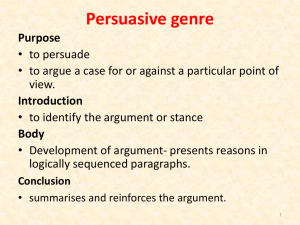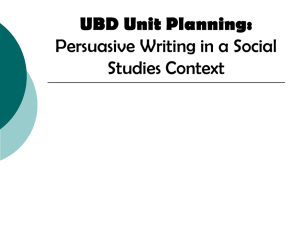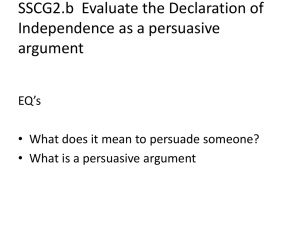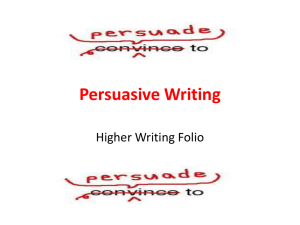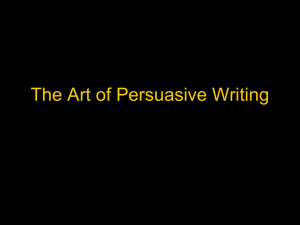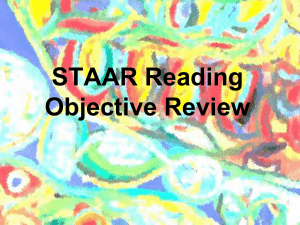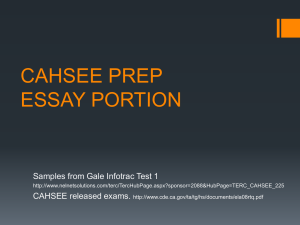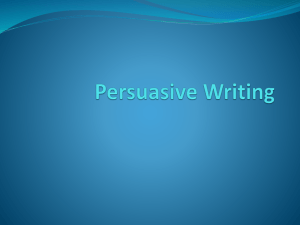Persuasive Writing: NAPLAN & Teaching Strategies
advertisement
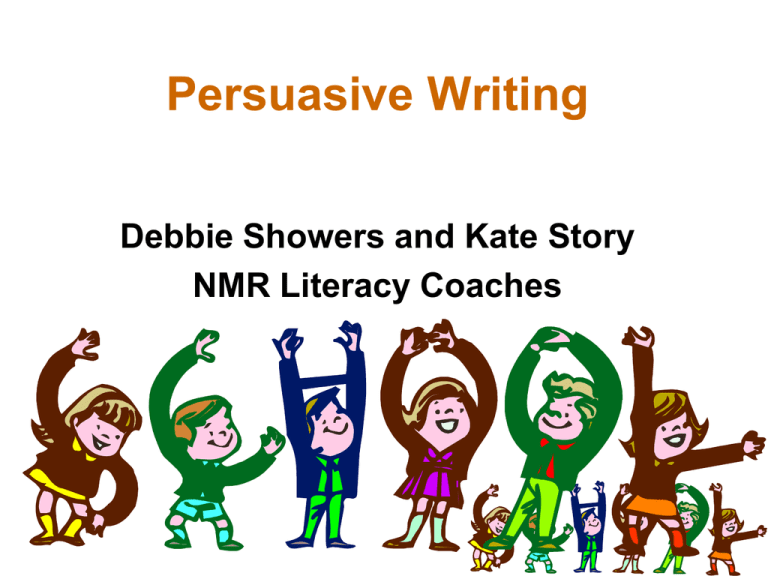
Persuasive Writing Debbie Showers and Kate Story NMR Literacy Coaches Outline of Day • Defining persuasive text – in the context and NAPLAN and beyond • Prompts • Using the marking guide • Success criteria • Teaching persuasive text – mini lessons • Writing persuasive text – what writers do • Resources • Assessment • Ultranet space What is persuasive writing? • Persuasive writing is where the writer attempts to persuade the reader to her or his point of view. • Writer presents their opinion and the offers reasons for this view. • Persuasive text covers arguments, letters, debates, advertisements, posters, poems, songs BUT that is not what NAPLAN requires. What NAPLAN wants • MUST convince reader of their opinions • Text MUST include an introduction, body and conclusion • May be presented as an essay, letter to the editor of a local paper or as text of a speech • It can be one sided (agree or disagree) or it can be a discussion • Easier to write for or against, not both What NAPLAN wants cont’d. • Must address 10 criteria (audience, text structure, ideas, persuasive devices, vocabulary, cohesion, paragraphing, sentence structure, punctuation, spelling) • Selection, organisation and relevance of ideas key • Persuasive devices a must • Writing stamina – you may build up The marking guide Criteria Skills Focus Audience Writer’s capacity to orient, engage and persuade reader Text structure Organisation of the structural components of a persuasive text (intro, body & conclusion) into appropriate & effective text structure Ideas Selection, relevance & elaboration of ideas for persuasive argument Persuasive devices Use and range of persuasive devices to enhance the writer’s position and persuade the reader Vocabulary Range & precision of contextually appropriate language choices Cohesion Control of multiple threads and relationships across the text, achieved through the use of referring words, ellipsis, text connectives, substitutions and word associations Paragraphing Segmenting of text into paragraphs that assists reader to follow line of argument Sentence structure Production of grammatically correct, structurally sound and meaningful sentences Punctuation Use of correct and appropriate punctuation to aid reading of text Spelling Accuracy of spelling and the difficulty of words used The language of persuasive texts • • • • • • • • Emotive words and phrases Present tense Specialised vocabulary Use of conjunctions First person Action verbs Facts and opinions Persuasive devices Persuasive devices • • • • • • • • • • • Repetition of words or phrases Exaggeration or hyperbole Questions that appeal to reader Stereotypes Quotes from authorities A call for action Posing of problem and suggestion of solution An appeal to the reader Rhetorical questions It’s a known fact… Groups of three NAPLAN asks for specialised vocabulary which requires research which you can’t do in timed test, so… • • • • Read alouds Shared reading Non fiction texts – print and multi media Encourage discussion and accountable talk • Don’t accept yes/no responses – children should justify their responses Teaching strategies • • • • • • Modelled writing Shared writing Guided writing Interactive writing Independent writing Shared reading and discussion of a variety of texts – use exemplars and other texts • Explicitly teach planning Teaching Persuasive Texts: Mini lessons • Choose your entry point following baseline assessment • Reading and language conventions mini lessons summary – over 10 session • 2010 Marking guide – spelling list p83 2010NarrativeMarkingGuide_web.pdf • Writing mini lessons – 5 ½ weeks of sessions 2011\NAPLAN writing mini lessons.docx Factors for writing a timed text • Writing stamina • Writing process is compacted, but still need to work through cycle • No time for research Assessing • Use the marking guide to assess writing • Modified marking guide rubric developed by Penny Krilis NMR Literacy Coach and Jan Smith from Glenroy College 2011\Marking Guide in Table.doc • VELS and NAPLAN 2011\Writing_Conversion2.xls • 2011\Years3-9VELSMappingFinal.doc Use a variety of resources • • • • • • • Go for something that polarises opinions Newspaper articles News clips Picture books Big books Video clips – You Tube, Fuse Persuasive Texts DVD Teacher resources • VCAA website – units of work for grades 3, 5, 7, 9 http://www.vcaa.vic.edu.au/prep10/naplan/ schools/persuasivewriting.html • Teachit.co.uk website http://www.teachit.co.uk/index.asp?currme nu=238 Literature and digital texts • • • • • • • • My Brother Dan’s Delicious The True Story of the Three Little Pigs Should There Be Zoos? Charlotte’s Web Miniscules animated series Earrings Romeo and Juliet Holes Baseline assessment • Give students a topic to write on • Time limit as per NAPLAN • Encourage them to plan, write, proofread, revise and edit • Assess against criteria • Make teaching decisions for whole group mini lessons and small group guided writing Writing a persuasive text • Do teachers deserve a 50% pay increase? • You have 15 minutes to persuade your reader to your point of view. • Assess with partner against criteria. • What do you need to work on…

